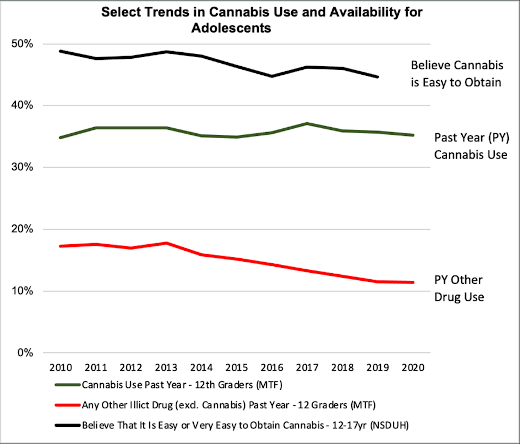 Two recent studies show that youth cannabis use is increasing in the US while use of other drugs and substances – notably alcohol and nicotine – are decreasing. However, further contextual data show this trend not to be associated with the creation of legal cannabis markets.
Two recent studies show that youth cannabis use is increasing in the US while use of other drugs and substances – notably alcohol and nicotine – are decreasing. However, further contextual data show this trend not to be associated with the creation of legal cannabis markets.
The first study looked at trends in poison control centres’ data, noting a 245% increase in adolescent cannabis misuse or abuse cases over the last two decades.
The second study examined data from 1991 to 2019 sourced from the well-known Monitoring the Future study, finding that cannabis use increased, particularly among socially engaged adolescents with little supervision.
Depending on how you look at the data (for example, specific age cohorts, frequency of use, etc), cannabis use among teenagers is either increasing or remaining steady at high levels (see graph below). Explaining why this is the case is more problematic.

A tempting, but incorrect, explanation blames the liberalisation of cannabis laws. The argument goes that cannabis legalisation increases the cannabis supply, leading to increased opportunities for youth misuse.
However, numerous studies have shown that laxer cannabis laws are not in fact a driver of adolescent use. And of those that do show a possible link, many have later been criticised for methodological problems, having failed to adjust the data adequately.
Prohibition simply keeps supply unregulated
“Legalisation by some states of cannabis has not been associated with an increase in adolescents’ cannabis use,” Nora Volkow, director of the National Institute on Drug Abuse (NIDA), said categorically during questioning by a US Senate committee.
That there should be no link between greater legal supply and greater youth usage may seem counterintuitive. But cannabis prohibition was never successful in eliminating supply; rather, it cemented distribution outside a regulated network. In fact in states where recreational cannabis has been legalised, legal supply should be less available to youth users, due to compliance with rules on minimum purchasing age.
Although reliable evidence on the intricacies of the illicit youth market are understandably hard to come by, survey data shows that over the last decade, as numerous states legalised cannabis, the perception among adolescents of whether or not cannabis was easy to obtain has remained flat or even declined (again, see graph above).
Simply put: youth cannabis misuse is an illicit activity facilitated through illicit channels.
While diversion opportunities from parents or other adults may have increased with legalisation, such supply lines were and are likely to remain on the margins and it is possible that for the youth market overall, not much has changed.
Additional public health measures are needed to reduce cannabis use among teens. However, adult cannabis legalisation seems to have little to do with it.
– Clayton Hale CannIntelligence contributing writer
Artwork: Emilian Robert Vicol







